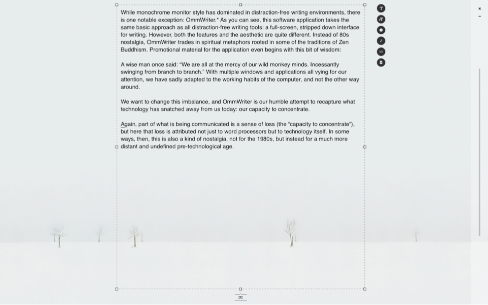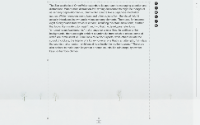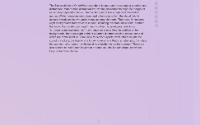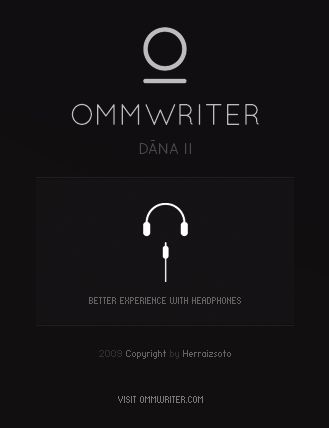The Sound of One Hand Typing
While monochrome monitor style has dominated in distraction-free writing environments, there is one notable exception: OmmWriter.

This software application takes the same basic approach as all distraction-free writing tools: a full-screen, stripped down interface for writing. However, both the features and the aesthetic are quite different. Instead of nostalgia for word processing in the 1980s, OmmWriter trades in spiritual metaphors rooted in some of the traditions of Zen Buddhism. Promotional material for the application (since changed) began with this bit of wisdom:
A wise man once said: “We are all at the mercy of our wild monkey minds. Incessantly swinging from branch to branch.” With multiple windows and applications all vying for our attention, we have sadly adapted to the working habits of the computer, and not the other way around.
We want to change this imbalance, and OmmWriter is our humble attempt to recapture what technology has snatched away from us today: our capacity to concentrate.
Again, part of what is being communicated is a sense of loss (the “capacity to concentrate”), but here that loss is attributed not just to the features of mainstream word processors but more generally to technology itself. In some ways, then, this is also a kind of nostalgia, not for the 1980s, but instead for a much more distant and undefined pre-technological age. The Zen aesthetic of OmmWriter extends to its approach to managing attention and distractions. Where most distraction-free writing environments might be thought of as sensory-deprivation tanks, OmmWriter is more like a Japanese meditation garden. While it removes menu bars and other objects from the visual field, it actually introduces its own audio-visual sensory elements. There are, for instance, eight backgrounds from which to choose, including this stark snow field, another that looks like a watercolor wash, and two that the developers refer to as “chromatherapy backgrounds” that change color over time.



In addition to the backgrounds, there are eight ambient soundtracks from which to chose, some of which are reminiscent of Brian Eno’s Music for Airports, while others imitate the sound of crickets, the interior of a library, or even one that is an attempt to “simulate the sounds that an unborn child would hear inside the mother’s womb.” There are also options to make each keystroke produce sounds like rain drops, typewriter keys, or bamboo chimes. Through these audio-visual features, OmmWriter does more than attempt to remove distractions. It is designed, instead, to be an immersive experience. The initial loading page for the application even displays the following graphic, which claims the user would have a “better experience through headphones”:

Bloggers and reviewers mention affect when referring to OmmWriter more than they seem to when discussing other distraction-free writing environments. Tina Sieber (2012) calls it “very calm and relaxing” and Whitson Gordon (2011) calls it “tranquil.” Robert Strohmeyer (2011) describes OmmWriter as “mind-clearing.” Of course, not all users appreciate this aspect of the application, with blogger Charlie Sorrel (2011) deriding it by saying that “OmmWriter is great for text-editing yoga hippies.”
In contrast, a reviewer at MacTalk who goes by the name “Pyrite” (2011) writes that his initial impression of OmmWriter’s audio-visual elements was that they were “a little tacky and gimmicky,” but that he was then surprised to find them “genuinely adding to the experience.” This reviewer was especially taken with the keyboard effects, which he describes as “simple, light and playful, and give you the feeling of being in a game.” The meaning of this software, then, extends beyond a simple means to an end, a way of producing text. Instead, it restructures and remediates the activity of writing, in much the same way that the introduction of fiberglass poles restructured and remediated the activity of polevaulting. Writing with this software is not just writing; it is also a game, or an immersive experience that potentially motivates a writer in unexpected ways.
As a mediational means, then, distraction-free writing software enables not only the production of writing, but also the production of a novel context for that activity. To borrow Prior and Shipka’s (2003) terminology, the employment of such software is a way of “selecting” and “structuring” one’s writing environment. Whether that selection involves a nostalgic green-on-black aesthetic or the sounds of bamboo chimes, the result is an attempt, on the writer’s part, to “tune their environments and get in tune with them” (p. 228). The point for this writer, then, is less the management of distraction as it is the overall “feel” of writing with this application. Though the feature set of OmmWriter is minimal compared to mainstream word processors, it has audio-visual features that contribute to an immersive and motivating experience for some users.